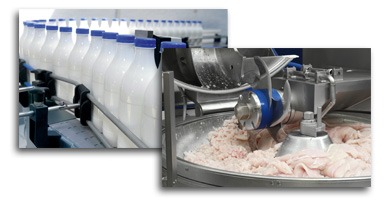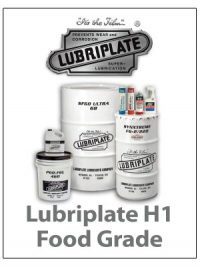Food Grade H1 Lubricants Reduce Contamination Threats in Food and Beverage Manufacturing
Food production consists of different types of equipment including pumps, mixers, chain drives, tanks, pipes, conveyors, compressors, automatic doors and many other units and systems—all of which need lubrication to work properly and safely. Plant managers realize that different machines require different types of lubricant and that stocking, tracking, and deploying lubricants effectively are critical to plant performance.
 Many types of lubricants are used in the food industry, including those that are registered food grade, NSF H1. These lubricants are permitted to have incidental contact—like dripping, leaking, and splashing—with food, as long as the amount doesn’t exceed the limit of 10 parts per million.
Many types of lubricants are used in the food industry, including those that are registered food grade, NSF H1. These lubricants are permitted to have incidental contact—like dripping, leaking, and splashing—with food, as long as the amount doesn’t exceed the limit of 10 parts per million.
NSF H1 lubricants use non-toxic base stocks, such as high-performance white mineral oils, vegetable oils, and certain esters. NSF HX1 additive packages are combined with these base stocks to provide performance characteristics required of formulated maintenance lubricants.
Non H1 lubricants—such as H2—use petroleum and other base stocks that are not allowed to come into contact with food under any circumstance. Generally speaking, they are less expensive and have historically performed better than H1 lubes. But with technology advances, H1 food grade lubricants are now safer and typically perform as well or better than their non-food-grade counterparts.
Above, Below
Some companies still follow the old “above the line, below the line” approach by using  expensive H1 lubricants above the production line, where there’s a chance of incidental contact with food, while using less expensive H2 lubricants below the line, where contact is less likely. But, this method does not completely eliminate the risk of unsafe lubricants splashing up on to passing food. Another risk to consider is a worker accidentally mistaking H1 for H2 and using each grade in the wrong place.
expensive H1 lubricants above the production line, where there’s a chance of incidental contact with food, while using less expensive H2 lubricants below the line, where contact is less likely. But, this method does not completely eliminate the risk of unsafe lubricants splashing up on to passing food. Another risk to consider is a worker accidentally mistaking H1 for H2 and using each grade in the wrong place.
To prevent contamination risks, many companies are converting their entire facility to H1 food-grade lubricants. A one hundred percent H1 food grade conversion program enables lubricant consolidation, a reduction in misapplication, and helps to ensure a safe product for the end consumer.
The Right Solution
To Jim Girard of Lubriplate Lubricants Co. in Newark, NJ and Toledo, OH, cheaper isn’t better when it comes to lubricants. “Too often, a lubricant supplier will start out with a boiler plate-type survey without listening to the customer. Just because an H1 food-grade lubricant works in a specific application, that does not mean it will work every time in the same application at different food and beverage processors.” Girard also stresses the importance of training maintenance engineering staff as the first step in building an effective lube program.
Functional criteria to consider when selecting a lubricant consist of fluid life, resistance to breakdown, and resistance to water washout in harsh operating environments. Whether choosing a food-grade hydraulic fluid, compressor fluid, gear fluid, or grease for your equipment’s needs, it’s important to work with a lubricant supplier. The suppliers’ technical service team should start by understanding the operating issues to find a solution that works, while ensuring HACCP principles, quality management systems, and food safety are supported in their recommendations.
The Bottom Line
- Using all NSF H1 registered lubricants in a facility can eliminate sources of potential contamination with hazardous substances while maintaining the same or even achieving better equipment performance.
- The newest lubricants designed for use in food and beverage facilities are capable of performing in the same way as a conventional industrial lubricant.
For more information about the products we offer from Lubriplate, visit our dedicated brand page.
Sources
Food Engineering
http://www.foodengineeringmag.com/
Special Supplement on lubricants making the grade
May 16, 2014
Jaan Koel, Contributing Editor
http://www.foodengineeringmag.com/articles/92195-special-supplement-on-lubricants-making-the-grade
“Food Grade Lubricants Come of Age”
March 7, 2012
Jaan Koel, Contributing Editor
http://www.foodengineeringmag.com/articles/89164-food-grade-lubricants-come-of-age
You must be logged in to post a comment.